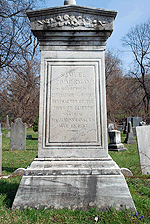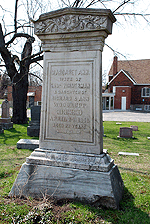|
Niagara Falls
SAMUEL ZIMMERMAN
a history
Samuel Zimmerman was an American by birth. He came to the Niagara Frontier in 1842. Zimmerman made his fortune as a contractor on projects such as the Second Welland Canal and the building of the Great Western Railroad from Hamilton to Niagara Falls. He was also a primary supporter of the first railway suspension bridge to be built across the Niagara River Gorge. By 1856, Samuel Zimmerman was the most important citizen in newly created Village of Clifton. He was recognized as one of founders of the Village of Clifton. Zimmerman had purchased extensive tracts of land in the Village of Elgin and the Village of Clifton. Within 15 years of arriving in Niagara, Zimmerman a shrewd financier/businessman had become the owner of most of the lands in the town. In a short period of time, Zimmerman became one of the richest men in Upper Canada. The initial portion of the Village of Clifton which was laid out in streets and building lots as early as 1832 by land owner, Captain Ogden Crieghton. Crieghton gave his future settlement the name “Clifton”. The name Clifton was derived from the town of the same name in England. Captain Ogden Crieghton, a half-pay British Army officer purchased the property from the Philip Bender family who had acquired this property in 1782 as part of a United Empire Loyalist (UEL) land grant. This land is today is commonly referred to as “the Center”. It encompasses a major portion of the primary tourist core in Niagara Falls, Ontario. Captain Crieghton did little more with his subdivisions than conducting some preliminary surveying before he left Niagara Falls four years later. In 1837, Captain Crieghton went to York (now Toronto) to fight in the rebellion. It was here that he died. The wife of Captain Creighton’s widow inherited ownership of his land holdings. She sold the property to contractor/financier Samuel Zimmerman. Zimmerman retained the name of “Clifton” for the fledgling village which he had purchased and promoted. He retained and maintained Captain Creighton’s street design. He had the Erie & Niagara Railway routed through his subdivision, since he was at that time the chief owner of the railroad company. Zimmerman created an estate property along the south side of Ferry Hill (Clifton Hill) that he called “Clifton Place”. On his estate, Zimmerman undertook to create many gardens and several large fountains. He planned to build a mansion that he hoped to live in once it was completed. The estate of Samuel Zimmerman occupied the entire south side of Ferry Hill (Clifton Hill). His estate was bounded by Clifton Hill (north), by the Niagara River (east), Robinson Street (south) and Ferry Road [Victoria Avenue] (west). Today this property is owned by HOCO (Harry Oakes Company). In May of 1855, Samuel Zimmerman opened the first bank in the area. It was called the Zimmerman Bank. The bank was incorporated under an act of Parliament. It had an authorized capital of a quarter of a million pounds sterling. This bank was located on the corner of Bridge Street at Clifton Avenue (south-west corner of current Zimmerman Avenue). This building also served as the Customs House and Post Office. In 1856, the Village of Clifton became large enough to warrant a post office. In 1856, the Village of Clifton and the north end Village of Elgin were amalgamated to become the Town of Clifton. The Village of Elgin had existed since 1848. Samuel Zimmerman had been living in Captain Creighton’s small Clifton cottage which stood near Ferry Road leading to the Maid of the Mist dock. The first buildings that Zimmerman built on his estate were four gatehouses. Each gatehouse was large enough to be a home in itself. A gatehouse was located at each of the four entrances to his estate. The Clifton Gate House was the last of four such gatehouses built by Samuel Zimmerman in 1856 to face each of the four sides of his 52 acre estate. The gatehouses were constructed of yellow brick imported from England. Zimmerman built a large stable for his horses and carriages. The stable was constructed of imported English yellow brick. The cost of the brick for this building alone was $18,000. The stables continued to exist until the mid 1950’s when the new Park Motor Hotel (Comfort Inn) complex incorporated it into the hotel structure. Next, Zimmerman began working on plans for his mansion which he called “Clifton Place”. His mansion was estimated to cost $175,000. The designer was Upjohn, the famous Boston architect. Samuel Zimmerman saw only the foundations of his mansion built before he was killed on March 12th 1857 in the Desjardins Canal Railway accident. Zimmerman had been in York (Toronto) that day and was on his way home when an axel on the railcar of the train snapped as it was crossing the swing bridge over the canal. The train derailed and plunged into the canal killing 59 persons including Samuel Zimmerman. The day Samuel Zimmerman was buried was declared a formal holiday in the Town of Clifton. Zimmerman’s estate was taken over by the Bank of Upper Canada which went bankrupt several years later. His estate was put up for sale. The Zimmerman Bank was changed to the Bank of Clifton and its charter was surrendered in 1863. United States Senator John T. Bush of Buffalo, New York bought Zimmerman’s at the bargain price of 25 cents on the dollar. Bush bought Clifton Place, the Clifton House along with extensive adjoining properties. Bush hired John Latshaw, a prominent builder and architect from nearby Drummondville. Latshaw was to build an Italian villa upon Zimmerman old foundations. The Bush mansion contained a great hall measuring 16 feet wide and 90 feet long running through the center of the main floor. The main floor consisted of five large rooms and a kitchen. The second floor consisted of five huge bedrooms. The third floor consisted of a theatre complete with a stage. A solid walnut winding staircase allowed access to the various floors. During construction, six thousand (6,000) board feet of black walnut was used. The doors were ten feet high. Three hundred tons of flat stone went into the walls and hand cut limestone went into the stone trim. Senator Bush and his family lived in the mansion for the next 50 years. The view of Niagara Falls was available from the many windows on the upper floors, the balconies and from a little stone turret built into one wing of the mansion. To reach the turret, one had to climb out of the window and walk across the slate roof. Originally the mansion was heated by large fireplaces however in later years it was heated by two large furnaces. Lighting was originally by oil lamps and but was later converted to electricity. Following the death of Senator Bush, his daughter Miss Josephine Bush continued to live in the mansion until 1927. In 1928, Miss Bush sold the Bush Estate to Harry Oakes Welland Securities. For several years after Welland Securities purchased the estate, two of the gatehouses were used as private residences. In 1937, Welland Securities began using the Clifton Gate House as their general office. After some time, the Clifton Gate House was used as an antique gun museum and later a souvenir store. The mansion was left vacant for ten years when Harry Oakes (Welland Securities) announced it would be torn down. Despite a public outcry to preserve the mansion, it was completely demolished by June 1st 1937. Of the four gatehouses, the ones facing Queen Victoria Park and Robinson Street had been removed long ago. The Victoria Avenue gatehouse was demolished in the mid-1950’s. By 1937, only two gatehouses and the stable remained standing. The last of the gatehouses (Clifton Hill) was removed in 1965. In November of 1965, the 109 year old Clifton Gate House located on the south side Clifton Hill between the Park Motor Hotel (Comfort Inn) and the Fallsway Hotel (Quality Inn) was demolished to make way for a two storey building worth $170,000. Welland Securities (now Hoco) announced the new building measuring 100 feet by 80 feet would house the new Hollywood Wax Museum on the second floor. Five other stores were located on the first floor. Samuel Zimmerman had been buried in a private burial vault on the grounds of his estate but his remains were later reintered in the cemetery of the St. David’s Methodist Church along side his wife. A large stone fountain built by Samuel Zimmerman below the moraine (now Queen Victoria Park) for $12,000. This fountain remains today. In 1885, the property below the moraine became part of the Queen Victoria Niagara Falls Park. In the late 1950’s, the Park Motor Hotel (Comfort Inn) and the Fallsway Hotel (Quality Hotel) were built on a large portion of the former estate. In 2009, The Quality Hotel was demolished to make room for new developments.
Date last updated:
February 13, 2012
THANK YOU FOR VISITING
a
history
|
||||||||||

